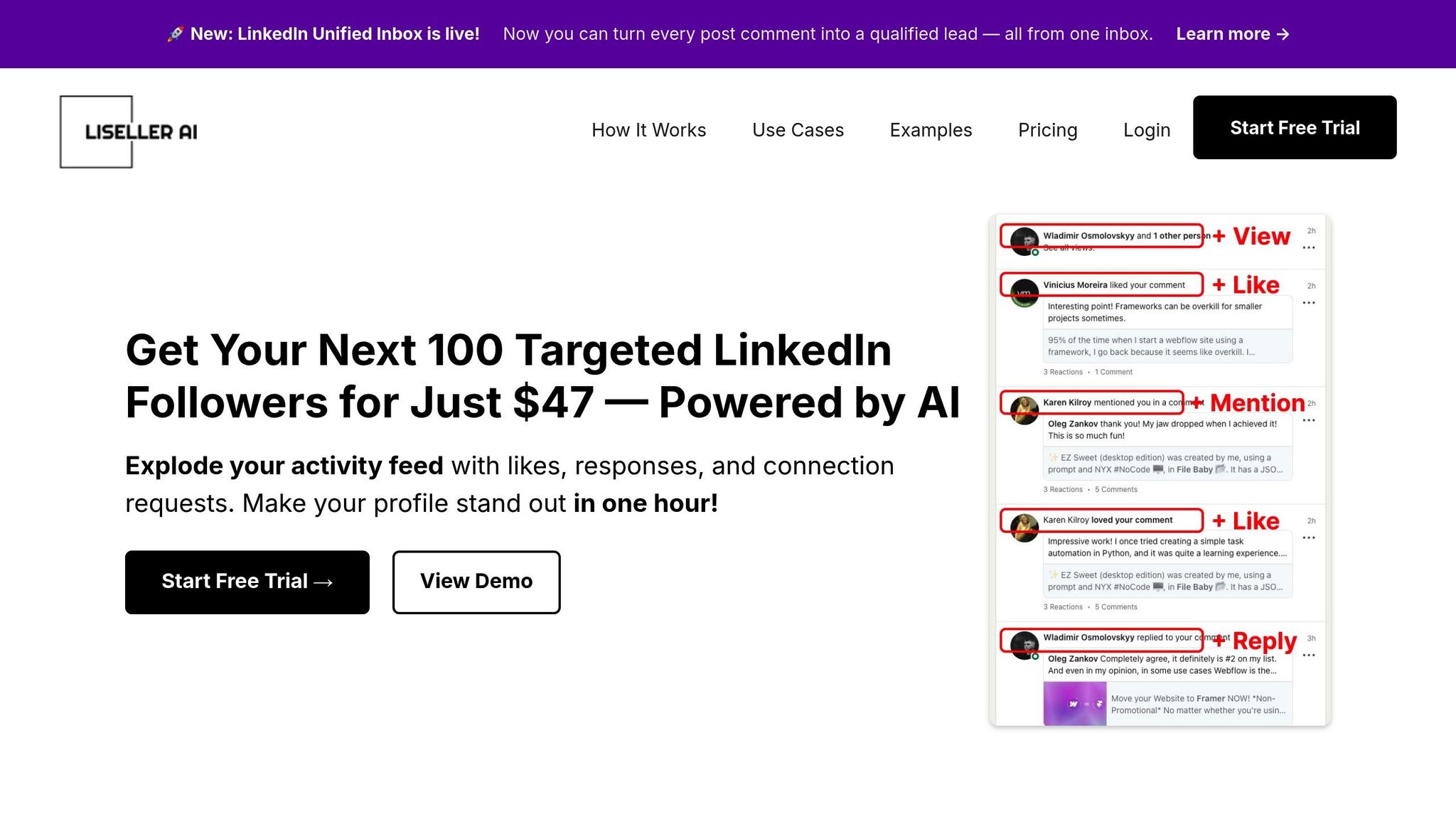How A/B Testing Boosts LinkedIn Engagement

A/B testing on LinkedIn is a powerful way to figure out what content resonates most with your audience. By comparing two or more post variations, you can identify what drives higher likes, comments, shares, and profile views. The challenge? Doing this manually is time-consuming and prone to errors. Enter tools like LiSeller, which automate post tracking, comment generation, and performance analysis, making the process faster and more efficient.
Key Takeaways:
- Manual A/B Testing: Full control but time-intensive, error-prone, and hard to manage at scale.
- AI Tools (e.g., LiSeller): Automate repetitive tasks, handle multiple campaigns, and provide consistent insights, though they may lack the personal touch of manual methods.
Quick Comparison:
| Aspect | Manual A/B Testing | AI Tools (LiSeller) |
|---|---|---|
| Automation | Requires manual effort for every step | Automates tracking, commenting, analysis |
| Scalability | Limited to small-scale testing | Handles up to 50 campaigns simultaneously |
| Accuracy | Prone to human error | Data-driven and consistent |
| Efficiency | Time-consuming | Saves time by automating tasks |
For most professionals, AI-powered tools offer a practical way to grow their LinkedIn presence while saving time and resources. Combine automation with human oversight to ensure your content feels personal while maximizing engagement.
What Is A/B Testing For LinkedIn Content? - Get Linked Together
1. Manual A/B Testing Methods
Boosting LinkedIn engagement often starts with manual A/B testing, where you take charge of creating, tracking, and analyzing different content variations yourself. While this hands-on method gives you full control, it comes with challenges that can complicate the process. These hurdles highlight the differences between manual testing and AI-driven automation.
Automation Capabilities
Manual A/B testing lacks any form of automation. Every step - designing content variations, tracking metrics, and analyzing results - requires your direct involvement. This means logging into LinkedIn multiple times a day to manually monitor likes, comments, shares, and connection requests for each post. On top of that, you’ll need to calculate engagement rates and try to spot audience behavior patterns yourself.
If you’re testing strategies like comment engagement, it gets even more demanding. You’ll need to actively interact with your audience and track responses, which can quickly become a time sink.
Scalability
Scaling up manual A/B testing is a tough challenge. Testing multiple variables - like posting times, content types, and engagement strategies - can quickly spiral into an unmanageable workload. Many professionals find it nearly impossible to juggle several tests at once, limiting their ability to fine-tune different aspects of their LinkedIn strategy simultaneously.
Accuracy of Insights
Human error is a big risk with manual data collection. Recording engagement metrics by hand - especially across numerous posts over time - leaves plenty of room for mistakes. You might miss out on interactions that happen outside your monitoring windows or misrecord key data points, which could skew your results.
Consistency is another hurdle. Factors like fluctuating posting times, changes in audience behavior, or shifts in LinkedIn’s algorithm can disrupt testing conditions, making it harder to draw reliable conclusions.
Efficiency
Manual A/B testing is time-intensive. Even straightforward tests require a significant investment of effort, pulling your focus away from other priorities.
This inefficiency also comes with an opportunity cost. The hours spent analyzing metrics could be used to create fresh content, engage with your network, or tackle other business tasks. For many professionals, the growing workload eventually makes manual testing unsustainable alongside their day-to-day responsibilities.
2. AI-Powered Tools like LiSeller

AI tools are revolutionizing A/B testing on LinkedIn by eliminating manual hurdles and automating data analysis. Platforms like LiSeller streamline the process, making LinkedIn growth strategies more efficient and effective.
Automation Capabilities
Tools like LiSeller take automation to the next level by actively monitoring LinkedIn feeds for engagement opportunities. Its AI agent scans posts, evaluates content relevance, and generates personalized comments that align with your brand's tone. Using an advanced filtering system, it ensures content quality while targeting the right audience. By leveraging LinkedIn's official API, LiSeller stays compliant while delivering consistent engagement across campaigns.
One standout feature is its ability to create customizable AI-generated comments. You can define specific parameters for tone, style, and messaging, allowing the platform to generate responses that feel authentic - without the need for manual input.
Scalability
LiSeller is built to handle large-scale A/B testing. It supports up to 50 campaigns at once, letting you test different audience segments and content types simultaneously. With Boolean search capabilities, you can fine-tune targeting by keywords and monitor engagement from select profiles. It also allows up to 10 LinkedIn accounts to be connected, making it ideal for teams managing campaigns across multiple departments or representatives.
Accuracy of Insights
The platform tracks key metrics like likes, comments, shares, and connection requests automatically. Its consistent filtering ensures reliable testing conditions, reducing the chance of skewed results. Plus, CRM integration links LinkedIn engagement data with broader customer relationship metrics. This provides a clearer picture of how your testing strategies influence business outcomes.
Efficiency
LiSeller’s automation saves time by taking over the repetitive tasks of A/B testing. Instead of manually tracking performance, professionals can focus on refining their strategies. The platform’s audience targeting feature allows you to set parameters once, and it continuously identifies new opportunities. With its auto-posting capability, content testing becomes even more streamlined, eliminating the need for constant manual updates.
sbb-itb-df6a70c
Pros and Cons
Manual A/B testing and AI-powered tools each have their own strengths and limitations. Choosing the right approach depends on your specific needs, resources, and goals. Here's a closer look at how these two methods compare.
Manual A/B testing offers full control over every aspect of your experiments. You can fine-tune test conditions and ensure your messaging aligns perfectly with your brand. This method works well for small-scale campaigns or situations where personalized oversight is essential.
That said, manual testing can quickly become overwhelming as your campaigns grow. Creating multiple variations, tracking performance, and analyzing results can take up significant time and energy.
AI-powered tools like LiSeller, on the other hand, simplify the process by automating the most time-consuming tasks. The platform manages post monitoring, comment creation, and performance tracking across multiple campaigns simultaneously. This automation makes large-scale testing more manageable, freeing you to focus on strategic decisions rather than repetitive tasks.
The downside? You sacrifice some direct control. While AI tools offer customization options, they may not capture the subtle nuances that resonate deeply with your audience. Over-relying on automation without proper oversight can lead to engagement that feels less personal or authentic.
Here’s a side-by-side comparison of the two approaches:
| Aspect | Manual A/B Testing | AI-Powered Tools (LiSeller) |
|---|---|---|
| Automation | Requires manual setup, tracking, and analysis | Automates content selection, commenting, and tracking |
| Scalability | Limited by human capacity; inefficient at scale | Manages up to 50 campaigns and 10 LinkedIn accounts simultaneously |
| Accuracy | High control but prone to human error or bias | Consistent, data-driven analysis with objective metrics |
| Efficiency | Time-intensive; requires significant monitoring | Faster iteration and quicker insights through automation |
| Resource Allocation | Demands more staff time and analysis costs | Optimizes resources with targeted, automated decisions |
| Brand Control | Full oversight of messaging and alignment | Customizable but needs human review for authenticity |
Manual testing requires significant staff time for data collection and analysis, while AI-powered platforms like LiSeller streamline these processes. By automating repetitive tasks, teams can allocate resources more effectively, focusing on strategies that drive meaningful engagement.
When it comes to maintaining brand consistency, manual methods provide immediate oversight but demand constant attention. LiSeller addresses this with customizable comment templates and post filters that align with brand guidelines. However, human review remains essential to ensure interactions feel genuine and resonate with your audience.
Conclusion
When comparing manual methods to AI-driven testing, it's clear that AI-powered A/B testing takes the lead for optimizing LinkedIn engagement on a larger scale. While manual testing gives you full control, it simply can't compete with the speed and consistency that automated platforms bring to the table.
AI tools, like LiSeller, are designed to handle the heavy lifting. Managing 5-10 posts manually each week might be feasible, but scaling up to hundreds of posts monthly becomes overwhelming. With features like AI filtering and automated comment generation, LiSeller ensures consistent results while allowing your team to focus on high-level strategy instead of repetitive tasks.
The advantage lies in how AI tools streamline your workflow. They allow for rapid testing and adjustments, so instead of weeks spent analyzing a single campaign, you can test multiple variables and refine your strategy in just days. This not only saves time but also optimizes your resources, enabling smarter, faster decision-making.
From a cost perspective, AI automation also delivers more value. It reduces the expenses tied to manual labor while driving better engagement through targeted, data-driven strategies. The result? A stronger, more effective LinkedIn presence.
The key to success lies in blending AI automation with thoughtful human input. Use tools like LiSeller's customizable templates and filtering options to maintain brand consistency, but keep an eye on performance metrics and adjust your approach as needed. This hybrid strategy ensures efficiency without sacrificing the personal touch that makes your content resonate.
For most businesses, the decision is clear: adopting AI-powered A/B testing is essential to thrive in LinkedIn’s competitive environment. By saving time and resources, you can focus on building relationships and crafting content that truly connects with your audience.
FAQs
How can A/B testing help improve LinkedIn engagement, such as likes, comments, and shares?
A/B testing is a powerful way to boost engagement on LinkedIn. It works by letting you test different versions of your content - such as headlines, images, or calls-to-action - to determine which one connects best with your audience.
By diving into the results, you can uncover what grabs attention and sparks interaction, helping you fine-tune your content strategy. This approach ensures you're consistently delivering content that drives more likes, comments, and shares. Over time, these small adjustments can make a big difference in strengthening your LinkedIn presence.
What are the benefits of using AI tools like LiSeller for A/B testing on LinkedIn?
AI tools such as LiSeller make A/B testing easier and more efficient by providing fast, data-based insights. They process large amounts of data in real time, reducing the risk of human error and allowing for faster tweaks to engagement strategies.
LiSeller automates the entire testing process - from setup to iteration - saving both time and effort while maintaining reliable and consistent results. This gives users the freedom to concentrate on improving their LinkedIn presence, increasing profile visibility, and forming meaningful connections with greater ease.
How can businesses keep LinkedIn engagement personal while using automation tools?
Businesses can keep their LinkedIn presence personal by blending automation with genuine interaction. Automation tools are great for handling repetitive tasks like sending connection requests or keeping track of posts. But when it comes to meaningful engagement - like replying to messages or leaving thoughtful comments on posts - it's best to take a hands-on approach.
AI tools can lend a hand by crafting context-sensitive comments and messages that come across as natural and relatable. The key is finding the right balance between using automation to save time and dedicating human effort to build authentic relationships. This way, businesses can manage their LinkedIn activity efficiently while still making real connections.
